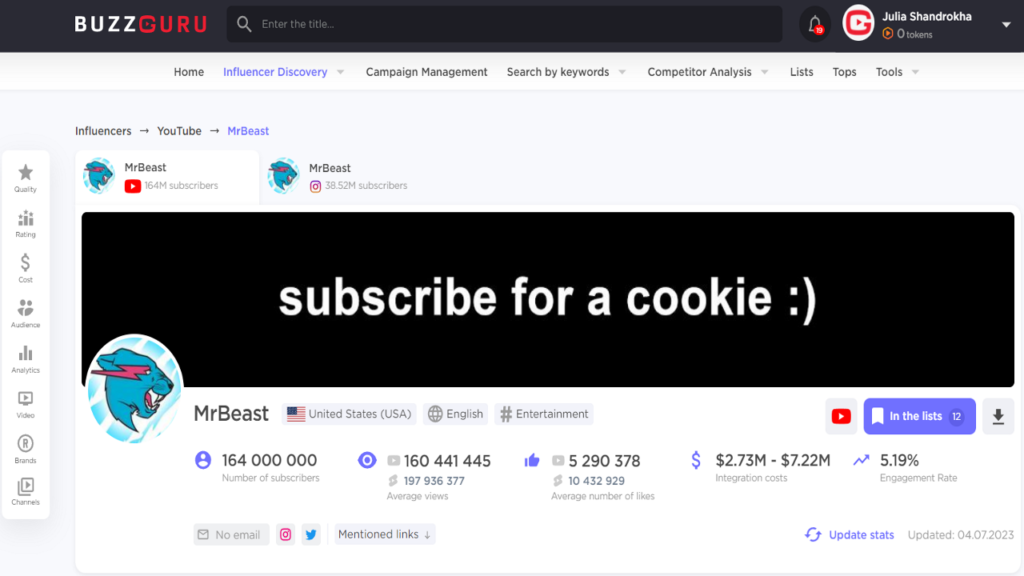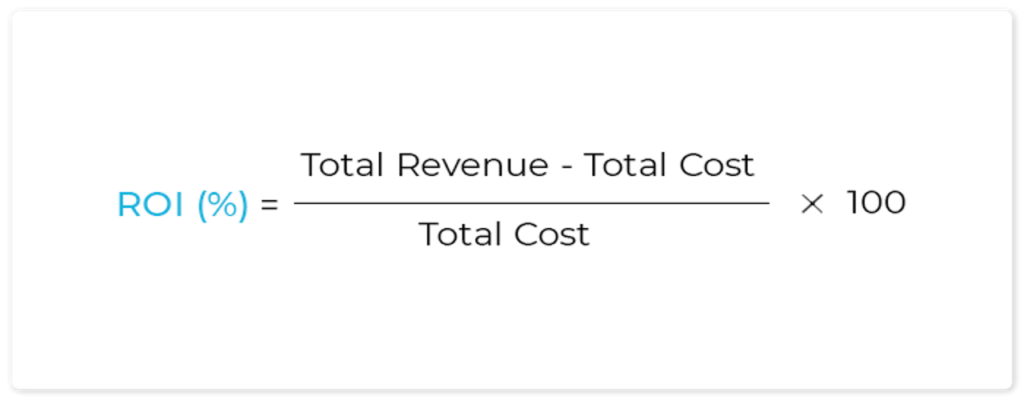
Table of Contents
-
INTRODUCTION: WHAT MAKES INFLUENCER MARKETING EFFECTIVE?
-
INFLUENCER MARKETING RETURN ON INVESTMENT: HOW TO MEASURE?
INFLUENCER MARKETING RETURN ON INVESTMENT FORMULA
-
HOW TO TRACK ROI?
-
FEATURES OF INVESTMENT IN INFLUENCERS ON INSTAGRAM AND YOUTUBE
-
WRAPPING UP
One of the main reasons businesses collaborate with creators is a high return on investment influencer marketing brings. And marketing metrics are just as important to managers as health metrics are to doctors and patients. They help measure the success of the efforts and collaborations, correctly assess the performance of the campaign, and forecast what to expect in the future.
INTRODUCTION: WHAT MAKES INFLUENCER MARKETING EFFECTIVE?
Initially, the idea of “influence” in advertising originated in 1940 and was called the “two-stage communication flow”. Its concept was based on the fact that a direct impact on people through the media can not always bring the desired effect. But if this or that information comes to them from friends or family, then it influences people and their opinions much more.
Over time, this idea has undergone various transformations. At first, brands used celebrities in their marketing campaigns to make consumers more willing to buy their products. Then, in connection with the development of technology, this method moved to the Internet. When social networks gained wide popularity, the current influencer marketing appeared.
Influencer marketing is not just a story about creating advertising campaigns with social media influencers. This is an opportunity to form a community of brand adherents.
According to the study, 94% of marketers find collaboration with influencers very profitable and effective. The results also showed that 90% of consumers willingly follow the recommendations of creators. While only 33% of consumers trust traditional advertising.
And the facts backup and confirm the statistics. Thus, the sportswear brand Adidas managed to increase its sales by 24.2% in the US, thanks to its work with influencers. To attract a young audience, they launched an Instagram contest with the hashtag #MyNeoShoot, offering the followers to win six items of clothing. Thanks to influencers, millions of subscribers learned about this promotion. As a result of this influencer marketing campaign, Adidas received about 12,000 entries for the contest, while the hashtag received more than 71,000 mentions. Moreover, up to 41,000 new subscribers joined the company’s official Instagram account.
INFLUENCER MARKETING RETURN ON INVESTMENT: HOW TO MEASURE?
Measuring the results of an influencer marketing campaign on social networks can be tricky. First of all, set specific goals: increase brand awareness or trust in the brand, increase the number of sales or clicks, get feedback, create unusual content or attract a new audience. Then, strategize, write a brief, and select the right influencer. If you want to make your life easier, you can opt for an influencer marketing agency, such as Famesters. A dedicated team of experienced influencer marketing specialists will get you all the metrics and detailed reports.
So, what figures and metrics to pay special attention to?
When choosing creators, pay attention to their performance in past campaigns or ask them to provide information about these results.
You can preliminary evaluate the overall channel quality with 4 important metrics:
- The engagement rate, % – median audience engagement rate for the last 10 posts;
- Number of likes, % – median likes to subscribers for the last 10 posts;
- Number of comments – median comments per 1 000 likes for the last 10 posts;
- Distribution of likes – the difference in the number of likes between posts.

One of the most important questions that worry marketers is the overall cost of the influencer marketing campaign and the cost of each selected influencer’s services. To calculate it, you need to know the influencer’s CPM: it differs from category of content to category and from country to country. For example, a YouTube channel from India that posts entertaining videos will have lower CPM than an educational channel from Canada. Knowing the CPM, you can see how many views the influencer’s videos get on average, and calculate the fair cost.
Everything is clear with statistical data on this or that influencer – either you collect it bit by bit yourself before the start of integration, or trust a professional. But what to do with the results of a promotional integration? How to evaluate success? How to understand that, for example, sales growth is provided exactly by a collaboration with an influencer?
There is an indicator that will help answer all these questions. It is a return on investment. Influencer marketing return on investment definition is simple – it is revenue generated as a result of the costs of developing a marketing campaign with social media influencers.
ROI from influencer marketing is the main indicator for evaluating its profitability, measuring the impact on profit of investment in marketing or expenses associated with the organization of sales. Since it is expressed as a percentage, its value for any division of the company, region in which it operates, or product line can be compared with the indicator for other divisions, regions or product lines, or with the overall value for the company. The company can also compare it with the performance of other competitors or other companies whose reports are publicly available.
INFLUENCER MARKETING RETURN ON INVESTMENT FORMULA
The purpose of calculating ROI is to determine the level of income per unit of expenses (in monetary terms).
The calculation algorithm consists of the following steps:
- Determine what ROI you need to calculate (total, average, per channel).
- Calculate the cost of content creation.
- Determine the percentage of content usage (usually no more than 50%).
- Calculate the return by applying the following formula: ROI = (Income from investments – expenses) / Expense * 100%

So here is an example of how you can evaluate the return on investment in influencer marketing. Imagine that you have invested $30000 in 10 publications from 10 influencers. Then, the price for one placement will be $3000. If the sales volume amounted to $200000, then the cost recovery amount is calculated according to the formula: revenue minus costs.
$200000 – $30000 = $170000
Therefore, we calculate the ROI (170.000/30.000)*100% = 566%. Then the cost of the campaign paid off five and a half times.
At first glance, ROI from influencer marketing looks a little hazy. It may seem difficult to specifically calculate how many sales or interactions influencer posts will generate. But you can analyze ROI using these indicators:
- audience reach;
- engagement;
- interactions;
- subscriptions;
- traffic;
- application uploads;
- the growth of subscribers on the brand’s official pages;
- sales.
The metrics to measure have to correspond with the goals set. Famesters experts help make these things clearer and easier to understand.
According to statistics, 81% of marketers pay the most attention to audience engagement indicators (the number of users who saw the post, their likes, comments and reposts). Using influencer marketing, they are betting on brand awareness and brand loyalty. After all, the main idea of such a promotion is to gain the trust of consumers and make them support the brand. Therefore, it is important to find creators who can later become the so-called ambassadors for your products.
HOW TO TRACK ROI?
There are several ways you can track ROI from influencer marketing. This could be an influencer marketing platform, a dedicated marketing analytics software, or professionals’ help. Let’s find out what will help you track these indicators in more detail.
It is quite simple to analyze the growth of subscribers on the official pages of the brand or the number of registrations on the site. You need to track these indicators within a week or two after the creators publish their posts. Most of the new users or followers during this period will be brought to you by the posts from campaigns with influencers. Yes, you have to track organic traffic during this period, too.
One easy way to track how many clicks to your site or service have been generated by an influencer is to use custom UTM tags. The influencer should attach such a link to a post about your products. You can also use promotional codes with discounts for your product in influencer posts and see how many sales each post brings.
If you want to understand how much brand awareness or audience engagement has grown, you need to analyze creator posts. The number of likes, comments, and shares will indicate how effective each influencer’s post is.
Outreach, impressions, and engagement are the most commonly used metrics when summarizing an influencer campaign, but they are not the only metrics to rely on. Other performance parameters give an idea of the success of the collaboration with creators.
Outreach shows the potential audience that can see the influencer’s content. It is important to pay attention to this indicator when planning your marketing campaign.
But estimating the benefits of outreach is not easy. And if the creator even has a million subscribers, not everyone will be able to see the post physically. Therefore, it is also important to look at another parameter – impressions, the number of users who saw the influencer’s post. The ratio of outreach and impressions will give a more realistic picture.
Another important metric when collaborating with influencers is engagement. Thanks to this parameter, you can assess the level of interest of subscribers to the creator’s posts. Engagement indicators include likes, comments, video views, and reposts. They can also change or be supplemented depending on the social network in which the influencer is represented. For YouTube, this can be viewing depth, for Instagram it can be “save to favorites”.
However, at present, the indicators of reach and engagement are gradually fading into the background. An influencer can generate real sales for a business by converting followers into loyal customers. And the results of campaigns can be measured by sales growth.
To estimate ROI in influencer marketing, you also need to pay attention to metrics such as direct sales, click-through rate (CTR), and app uploads. To track direct sales, you can use promotional codes and affiliate links that an influencer indicates in advertising messages.
Unique affiliate links and promotional codes for marketing campaigns allow you to track online sales. Influencers can earn a commission on these sales. Links can also be used as a tool to get data on the number of visits to a website and the average cost of an order. If the company has a CRM set up, then this can be easily tracked.
Analyzing ROI, we can conclude that the advertising campaign was not particularly successful. But influencer marketing doesn’t just work directly. It is important to take into account that as a result of cooperation with the opinion leader, the overall brand awareness and audience loyalty have increased, the subscriber base of official accounts has increased, etc.
Also, do not forget about potential buyers who went to the site after seeing the publication. Site visitors can subscribe to a mailing list, add the site to their favorites, or make a call. In short, sometimes additional touch points may be required to convert into a purchase. Given this factor, the resulting ROI will be slightly higher than the ROI initially shows.
In any case, the main idea that influencer marketing embodies is to achieve the same influence, sorry for the tautology! And this means gaining the trust of consumers and making them true supporters of the brand.
FEATURES OF INVESTMENT IN INFLUENCERS ON INSTAGRAM AND YOUTUBE
Instagram has recently started showing important data, which has greatly simplified the process of managing ads. Previously, this was not the case, and tracking some data, for example, socio-demographics, was much harder.
To assess the reaction of the audience to an influencer’s advertising, you need to ask yourself the question: “Why was it made?”. If you get the results you expected, then the campaign can be considered successful.
For example, on YouTube, you can pay attention to the number of likes and comments. YouTube Analytics will show you how long a video has been watched. Thanks to this, we will be able to see, in percentage terms, the number of those who watched the video to the end, not skipping the brand advertising. If the video or its description section contains links to the site, you can easily calculate the frequency of transitions to the page.
The Famesters influencer marketing agency uses AI and other high-tech solutions to track important metrics. Also, it is common to request necessary data from the influencers or their agents.
WRAPPING UP
Businesses, as well as their marketing activities, must be based on clear data – then advertising campaigns work and the indicators go up. As we found out, tracking the effectiveness of influencer marketing is absolutely not difficult. There are metrics, formulas, and platforms that make this task easier. Also, you can always rely on experienced professionals from an influencer marketing agency.
For influencer marketing to be effective, do your research before partnering with any creator. Analyze the live audience and match it with your brand’s target audience. Find out whose content is popular with your customers. For example, this can be done using a regular client survey.
Analyze and then experiment with different opinion leaders and types of content, increasing the effectiveness of the channel with each campaign or single post. At Famesters, we always suggest testing different options to make a campaign more flexible and, in the end, choose what works best for a given brand. Influencer marketing really works, but like any other advertising channel, it requires high professionalism and knowledge.




